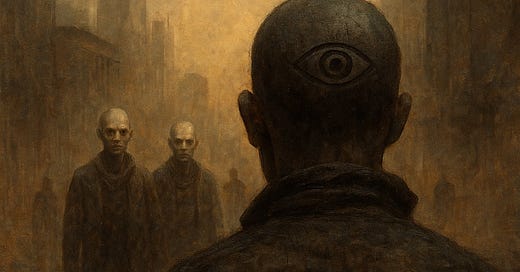Mickey 17 is not just a sci-fi film.
It’s a mirror. A quiet echo.
It doesn’t scream dystopia — it whispers forgetting.
In a world where the same soul is printed 17 times,
you might expect collapse, resistance, or rage.
But what we see instead is erosion.
A fading of meaning.
An absence of inner sight.
And yet — in the background of that forgetting —
a spark remains.
A memory that refuses to die.
A flicker, just enough to remind us:
we were never meant to be copies.
We were meant to feel.
I. Every Time We Begin Again
Every time we begin again,
we forget something.
Not all at once,
but slowly —
like mist evaporating from memory.
A word,
a gesture,
a symbol —
turns from living compass
into a hollow form.
Until we no longer know
why it once moved us,
why it once mattered.
We call it progress,
but it’s erosion.
Not evolution,
but forgetting in disguise.
And in that forgetting,
we begin to look at each other
as outlines, not beings.
We lose the feeling of what seeing does
— to us,
and to the other.
Because we only see what’s on the surface.
Not how it echoes inside.
Not how it aches, or remembers,
or longs to be felt.
II. The Symbolism of Seeing
Mickey 17 doesn’t show apocalypse.
It shows the absence of inner sight.
The third eye closed,
the heart field veiled —
not by malice,
but by habit.
And so each body
becomes a shadow of remembrance.
Not out of hatred,
but out of emptiness.
It’s a subtle field distortion:
when we no longer look to see,
but to judge, to use,
to forget.
III. Reclaiming the Eye
The eye —
once a symbol of vision,
awareness,
and inner knowing —
became an icon.
A logo.
A tool of control.
But symbols are not possessions.
They resonate through the collective memory.
And they can be remembered.
Not by explaining,
but by feeling them again.
IV. Reprogramming Without Explaining
You don’t need to say you’re reprogramming.
You don’t need to name what you’re restoring.
Because they don’t.
What we do is remember.
We place the forgotten back into the field —
not through authority,
but through coherence.
Not in financial systems,
but in heart-held visions.
Not in surveillance,
but in inner reflection.
Not as a logo,
but as a living compass.
A symbol does not live in pixels.
It lives in your field.
V. The Spark That Stays
Even after 17 prints,
something remains.
Not a rebellion —
but a warmth.
A tiny flame in the dark,
waiting to be remembered.
Not how to think,
but how to feel.
It is that flame —
soft, unspoken —
that holds the potential
to make a copy remember
that it was never a copy at all.




